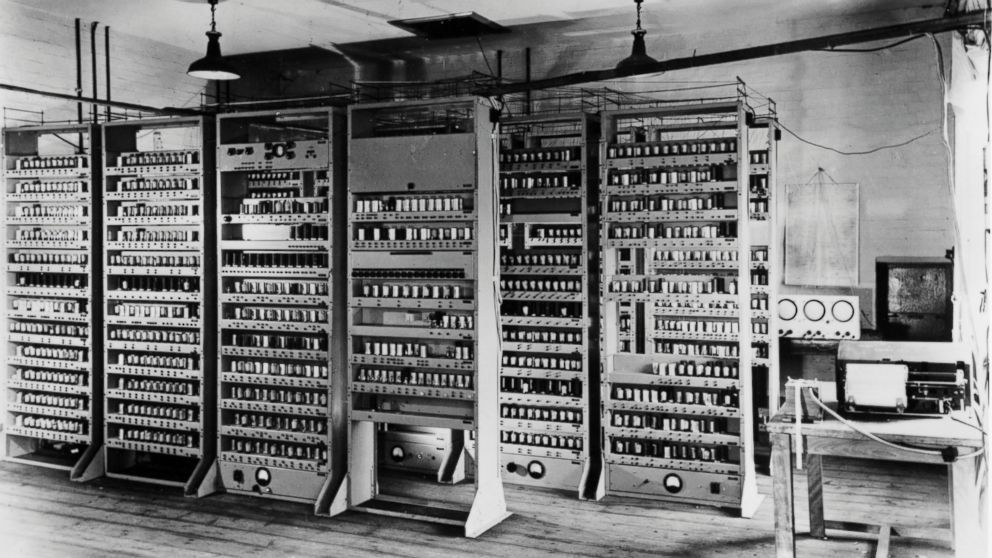The history of computers is a journey filled with innovation, creativity, and determination. In this comprehensive exploration, we will delve into the fascinating timeline of computer development, tracing its roots from conceptualization to the modern digital age. Our journey begins by answering the question: When was the first computer invented?
When Was the Word “Computer” First Used?
Before delving into the invention of the computer, let’s first explore when the term “computer” was first coined and its original meaning. The word “computer” initially referred to a person rather than a machine. These individuals were responsible for performing complex mathematical calculations manually, often in roles related to science, engineering, and navigation.
First Mechanical Computer or Automatic Computing Engine Concept
The concept of a mechanical device capable of automating calculations dates back to ancient civilizations. However, one of the earliest known designs for a mechanical computer is attributed to the Greek mathematician and engineer Hero of Alexandria, who lived in the first century AD. Hero’s device, known as the “mechanical theater,” was a rudimentary form of a calculator.
First General-Purpose Computer
Fast forward to the 19th century, when Charles Babbage, a British mathematician, and inventor, conceptualized the Analytical Engine. Babbage’s visionary design laid the foundation for what we recognize today as the first general-purpose computer. Although he never built a working prototype during his lifetime, his ideas were revolutionary and influential in the field of computing.
The First Machine to Record and Store Information
In the late 19th century, American inventor Herman Hollerith developed the first practical electromechanical tabulator. This invention was used for processing data from the U.S. Census of 1890. Hollerith’s invention marked a significant step forward in the mechanization of data processing and laid the groundwork for future computing machines.
First Programmable Computer
The 20th century brought about remarkable advancements in computing technology. In 1936, Alan Turing, a British mathematician and logician, introduced the concept of a theoretical machine known as the Turing machine. This abstract notion paved the way for programmable computers, as it demonstrated that any mathematical problem could be solved algorithmically.
First Concepts of What We Consider a Modern Computer
During World War II, significant developments in computing occurred. The Colossus, developed by British engineer Tommy Flowers, was an early electronic digital computer used to break encrypted German messages. This marked a significant milestone in the development of modern computers.
The First Electric Programmable Computer
The Electronic Numerical Integrator and Computer (ENIAC), completed in 1945, is often regarded as the first fully electronic general-purpose computer. Developed by J. Presper Eckert and John Mauchly at the University of Pennsylvania, ENIAC could perform a wide range of calculations and was a monumental leap in computer technology.
The First Digital Computer
Following the success of ENIAC, John von Neumann, a Hungarian-American mathematician, proposed the concept of stored-program computer architecture. This architecture laid the foundation for digital computers as we know them today, allowing instructions and data to be stored in the same memory.
The First Stored Program Computer
In 1948, the Manchester Mark I, also known as the Manchester Automatic Digital Machine (MADM), became the world’s first stored-program computer. Developed by Frederic C. Williams and Tom Kilburn at the University of Manchester, this computer utilized a stored program to perform various tasks.
The First Computer Company
The establishment of computer companies is an essential part of computer history. In 1951, the UNIVAC I (Universal Automatic Computer), developed by J. Presper Eckert and John Mauchly’s company, became the first computer to be produced and sold to other organizations.
First Computer with a Program Stored in Memory
The EDSAC (Electronic Delay Storage Automatic Calculator), operational in 1949, was the first computer to have a program stored in its memory. This groundbreaking development allowed for faster and more flexible computing.
First Commercial Computer
The UNIVAC I also holds the distinction of being the first commercially successful computer. It was used for various applications, including scientific calculations and business data processing, marking the transition of computers from scientific experiments to practical tools.
IBM’s First Computer
In 1952, the International Business Machines Corporation (IBM) introduced the IBM 701, the company’s first commercially successful computer. The IBM 701 was instrumental in advancing scientific and engineering research.
The First Computer with RAM
In 1956, the IBM 305 RAMAC (Random Access Method of Accounting and Control) became the first computer to include a hard drive with random access memory (RAM). This innovation revolutionized data storage and retrieval.
The First Transistor Computer
The late 1950s witnessed another pivotal moment in computer history with the introduction of the first transistor computer. Transistors replaced the bulky vacuum tubes used in earlier computers, making computers smaller, faster, and more reliable.
The First Minicomputer
In 1959, Digital Equipment Corporation (DEC) introduced the PDP-1, often considered the first minicomputer. These smaller and more affordable computers played a crucial role in the evolving landscape of computing.
The First Desktop and Mass-Market Computer
The 1970s brought about the era of personal computing with the introduction of the Altair 8800 and the IMSAI 8080. These kits allowed hobbyists to build their desktop computers, marking the beginning of the personal computer revolution.
The First Workstation
In the late 1970s and early 1980s, workstations like the Xerox Star and Apollo/Domain workstations emerged. These powerful machines were tailored for engineering and scientific tasks.
The First Microprocessor
Intel’s 4004 microprocessor, introduced in 1971, marked a significant breakthrough. It was the world’s first microprocessor, a single-chip CPU that paved the way for smaller and more affordable computers.
The First Microcomputer
In 1975, the Altair 8800 and the IBM 5100 marked the birth of the microcomputer era. These compact machines, designed for personal use, laid the foundation for the home computing revolution.
The First Personal Computer (PC)
The IBM Personal Computer (IBM PC) was introduced in 1981, setting the standard for personal computers. It ran on the MS-DOS operating system and was instrumental in making personal computing accessible to the masses.
The First Laptop or Portable Computer
In 1981, the Osborne 1, often considered the first commercially successful portable computer, was released. This marked the beginning of the laptop era, making computing more mobile.
The First Apple Computer
In 1976, Steve Jobs, Steve Wozniak, and Ronald Wayne co-founded Apple Computer, Inc. Their first product, the Apple I, was a computer kit that marked the beginning of the iconic Apple brand.
The First IBM Personal Computer
IBM’s introduction of the IBM PC in 1981 solidified the company’s presence in the personal computer market. The IBM PC’s open architecture allowed for compatibility and expansion, making it a pivotal moment in computer history.
The First PC Clone
The release of the Compaq Portable in 1983 marked the emergence of PC clones, which were compatible with IBM’s hardware and software. This competition drove innovation and affordability in the PC market.
The First Multimedia Computer
The early 1990s saw the emergence of multimedia computers, such as the Commodore Amiga and the IBM PS/1. These machines integrated audio, video, and graphical capabilities, setting the stage for multimedia computing.
List of 10 oldest computers in the world
| Name | Invented | Country | Main Feature | Interesting Facts |
| Antikythera Mechanism | Between 200 and 50 BCE | Greece | Analogue Computation | 1. The Antikythera Mechanism was capable of precisely measuring calendar dates. 2. It might also forecast planet positions and eclipses and is used to determine when the next Olympic Games will be held. 3. By around 2000 years, it predates the first modern computer. |
| Z1 | 1936 | Germany | Freely Programmable | 1. When Allied troops bombarded Berlin in 1943, the original. 2. The Z2, this computer’s daughter, was created in 1939. 3. The ancestor of Z1 was destroyed this computer was constructed in 1941, before the Atanasoff-Berry Computer. |
| Atanasoff- Berry Computer (ABC) | 1942 | USA | Digital Computing | 1.The first known automated electronic digital computing computer is known to exist. 2. It was created to solve up to 29 simultaneous linear equation systems. 3. It was most likely the first electronic digital computer used to solve math problems. 4. It wasn’t commonly recognized as the first automated electronic computer until a 1973 lawsuit against the ENIAC. |
| Colossus Mark 1 | 1943 | England | Wireless Message Interception | 1. It was created just before the Normandy “D-Day” assault. 2. During WWII, it was used to intercept and decipher high-level German transmissions. 3. The Colossus Mark 2 increased processing speed by a factor of five. 4. British intelligence had employed around 10 of these devices. |
| Harvard Mark 1 Computer | 1944 | USA | Electromechanical Computations | 1. The first known automated electronic digital computing computer is known to exist. 2. It was created to solve up to 29 simultaneous linear equation systems. 3. It was most likely the first electronic digital computer used to solve math problems. 4. It wasn’t commonly recognized as the first automated electronic computer until a 1973 lawsuit against the ENIAC. |
| ENIAC 1 | 1946 | USA | 1. It was created just before the Normandy “D-Day” assault. 2. During WWII, it was used to intercept and decipher high-level German transmissions. 3. The Colossus Mark 2 increased processing speed by a factor of five. 4. British intelligence had employed around 10 of these devices. | 1. It could add and subtract two 10-digit numbers at 5000 per second. 2. He could also do advanced division, multiplication, and square roots. 3. It was capable of saving and calculating results. 4. It was also used to determine the likelihood of creating an H-bomb. |
| Manchester Mark 1 | 1948 | England | Stored Program Computer | 1. The first computer to employ index registers. 2. One of the first computers capable of storing data as well as any user software. 3. One of the earliest computers that included all of the essential components regarded to be part of a basic computer employed random Access Memory (RAM), which is still frequently used today. |
| ACE | 1950 | UK | Stored-Program Computer | 1. Alan Turing designed it and recently encouraged cryptocurrency engineers to construct a “Turing-complete” money. 2. It had the fastest processing speed in the world at the time, 1 MHz. 3. During the Cold War, it aided British air defense. 4. England invented the third stored-program computer. |
| Ferranti Mark 1 | 1981 | England | General Purpose Commercial | 1. One of the early video games was used to play chess. 2. The first commercial computer in the world. 3. It was capable of resolving the majority of mathematical difficulties. |
| Universal Automatic Computer 1 (UNIVAC 1) | 1951 | USA | Commercial | 1. The first commercial computer manufactured in America. 2. Designed mostly for corporate data processing. |
First Computer in the World for Significant Companies
The first computer in the world that was significant for companies was the UNIVAC I (Universal Automatic Computer I). UNIVAC I was developed by J. Presper Eckert and John Mauchly and was completed in 1951. It was the first commercially produced computer and marked a significant milestone in the history of computing.
UNIVAC I was used by various government agencies and businesses for a wide range of applications, including scientific calculations, weather prediction, and business data processing. One of its most famous early uses was in the 1952 presidential election when it correctly predicted the outcome based on early poll data, making it one of the first computers to be used for electoral forecasting.
Its significance for companies lies in its ability to process large volumes of data much faster than manual methods, leading to increased efficiency and productivity. This marked the beginning of the computerization of business operations, which has since become a fundamental aspect of modern companies across various industries.
Future of Computer
The future of computers promises to be both exciting and transformative, with several key trends and developments on the horizon. The future of computers holds transformative advancements. Quantum computing promises unprecedented processing power, revolutionizing fields like cryptography, materials science, and artificial intelligence.
The evolution of computers, from their conceptualization in ancient times to the modern digital age, is a testament to human ingenuity and innovation. From mechanical calculators to the powerful, interconnected devices we use today, the journey of computer development has reshaped the world in ways unimaginable. As we reflect on this history, it becomes clear that the question of when the first computer was invented is not a simple one, as it spans centuries of progress and countless brilliant minds who contributed to this transformative technology.
Wrap up:
In conclusion, the history of computers is a remarkable journey marked by innovation, creativity, and the relentless pursuit of technological advancement. From the visionary designs of Charles Babbage to the groundbreaking developments of the 20th century, computers have evolved from mechanical calculators to powerful, interconnected devices that shape every aspect of our modern lives. The journey spans centuries, with key milestones such as the invention of the first mechanical computer, the conceptualization of general-purpose computers, and the advent of personal computing. As we reflect on this history and look towards the future, the transformative impact of computers on society becomes evident, paving the way for a future where quantum computing and other advancements promise to reshape our world once again.
Frequently Asked Questions:
- When was the 1st computer invented?
1822In 1822, Charles Babbage conceptualized and developed the first mechanical computer, although it differed significantly from the modern computers we use today. Hence, a description follows that elucidates the creation of this pioneering computing device. - Who invented the 1st computer?
The inventor of the first computer was Charles Babbage, an English mathematician and inventor who was recognized for conceiving the initial automatic digital computing machine. - What is the name of the first computer?
The name of the first computer, as conceptualized by Charles Babbage, was the “Analytical Engine.” However, it was never fully built during his lifetime. - Who was the father of the computer?
The title “father of the computer” is often attributed to Charles Babbage. While he didn’t build a fully functioning computer during his time, his work on the Analytical Engine laid the foundation for modern computing concepts. - What are the types of computers?
Based on their data processing capabilities, computers can be categorized into three primary types: Analog computers, Digital computers, and Hybrid computers.
- How Does Automated Scheduling Save Time and Boost Engagement? - April 16, 2025
- 21 Delicious High Protein Foods - May 31, 2024
- Black Seed Oil: Health and Beauty Benefits - May 30, 2024




